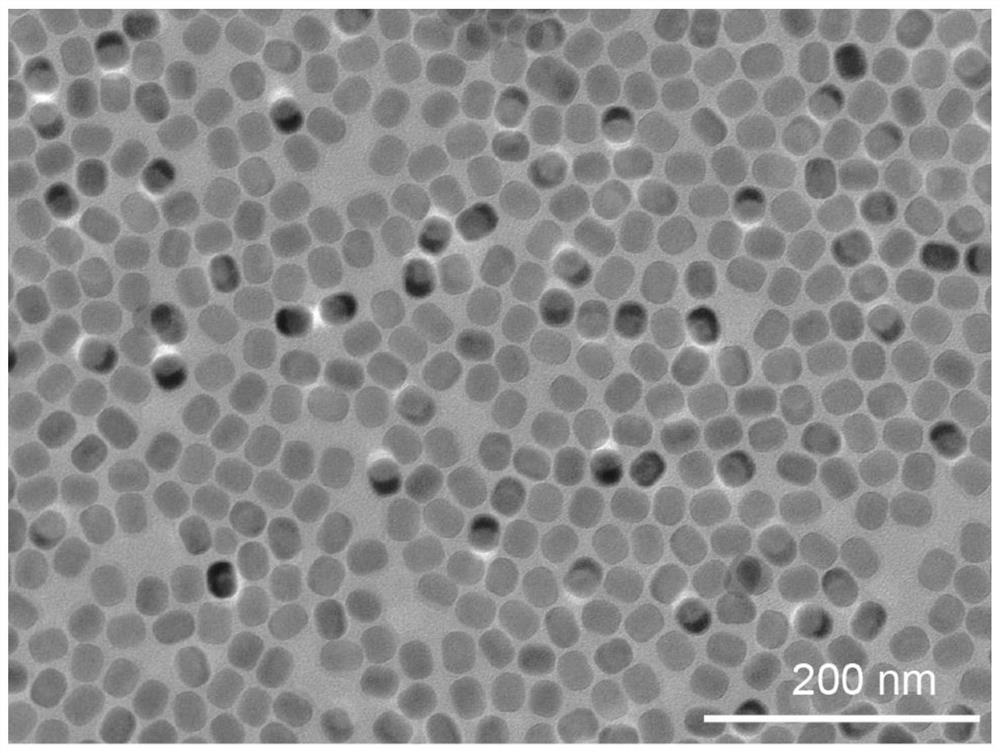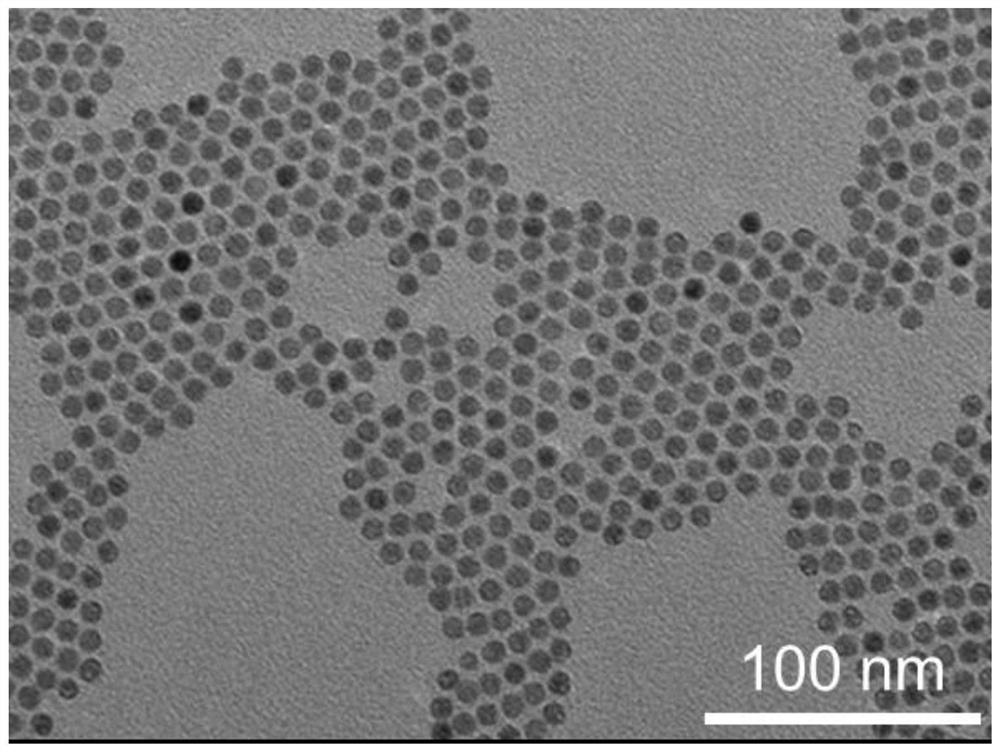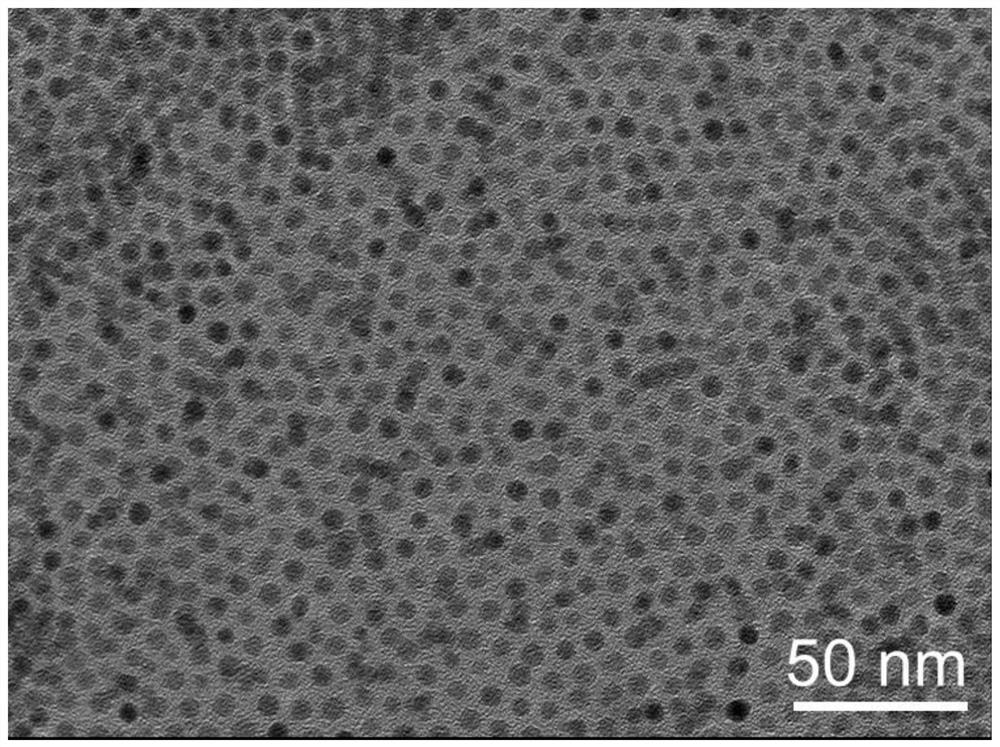Preparation and application of same-level rare earth luminescent probe based on luminescence lifetime change
A technology of rare earth luminescence and fluorescence lifetime, which is applied in the direction of luminescent materials, fluorescence/phosphorescence, nanotechnology for materials and surface science, etc. It can solve the problems of unrealized detection and achieve strong replaceability, high sensitivity, strong cosmetic effect
- Summary
- Abstract
- Description
- Claims
- Application Information
AI Technical Summary
Problems solved by technology
Method used
Image
Examples
Embodiment 1
[0094] Example 1: Nanoparticle NaYF 4 : Synthesis of Tm
[0095] Take 0.99mmol of YCl 3 and 0.01 mmol of TmCl 3 The solid powder was added to a 100-mL three-necked flask containing 6 mL of oleic acid and 15 mL of octadecene, and an air-condensing device was built after adding a magnet and a thermometer. The temperature was raised to 110°C under nitrogen atmosphere, and then lowered to room temperature after the chloride was completely dissolved. While stirring, 10 mL of methanol solution prepared by dissolving 4 mmol of ammonium fluoride and 2.5 mmol of sodium hydroxide was added dropwise to the reaction flask, and the reaction solution gradually became cloudy. After stirring at room temperature for 15 minutes, the temperature was gradually increased to 110°C, and methanol was removed under a flowing nitrogen atmosphere. Then, after vacuuming to remove the remaining low-boiling substances, the temperature was rapidly raised to 300° C. for 1 hour under nitrogen atmosphere. ...
Embodiment 2
[0097] Example 2: Nanoparticle NaYF 4 :Yb, NaYF 4 :Nd, NaYF 4 : Synthesis of Er
[0098] NaYF 4 :Yb, NaYF 4 :Nd, NaYF 4 : Synthesis steps of Er nanoparticles and NaYF 4 : The synthesis of Tm nanoparticles is the same, in which TmCl 3 Replace solid powder with YbCl 3 , NdCl 3 or ErCl 3 .
[0099] figure 2 is NaYF in this example 4 : Transmission electron micrograph of the Yb luminescent probe, the material size is 10nm, the material has good dispersibility, and the particle size is uniform.
[0100] image 3 is NaYF in this example 4 : Transmission electron micrograph of the Nd light-emitting probe, the material size is 6.5nm, the material has good dispersion and uniform particle size.
[0101] Figure 4 is NaYF in this example 4 : Transmission electron micrograph of the Er light-emitting probe, the material size is 38nm, the material has good dispersion and uniform particle size.
Embodiment 3
[0102] Example 3: Nanoparticle LiYF 4 :Nd, KYbF 3 , CaYbF 4 , BaYbF 4 Synthesis
[0103] LiYF 4 :Nd, KYbF 3 , CaYbF 4 , BaYbF 4 Synthetic steps of nanoparticles and NaYF 4 : The synthesis of Tm nanoparticles is the same, in which TmCl 3 Replace solid powder with YbCl 3 or NdCl 3, replace the NaOH solid with LiOH, KOH, Ca(OH) 2 or Ba(OH) 2 .
[0104] Figure 5 is LiYF in this example 4 : Transmission electron micrograph of the Nd luminescent probe, the material size is 31nm, the material has good dispersion and uniform particle size.
[0105] Image 6 is KYbF in this example 3 Transmission electron micrograph of the luminescent probe, the material size is 5nm, the material has good dispersibility, and the particle size is uniform.
[0106] Figure 7 is CaYbF in this example 4 Transmission electron micrograph of the luminescent probe, the size of the material is 10 nm, the material has good dispersibility, and the particle size is uniform.
[0107] Figure ...
PUM
| Property | Measurement | Unit |
|---|---|---|
| particle diameter | aaaaa | aaaaa |
| length | aaaaa | aaaaa |
Abstract
Description
Claims
Application Information
 Login to View More
Login to View More - R&D
- Intellectual Property
- Life Sciences
- Materials
- Tech Scout
- Unparalleled Data Quality
- Higher Quality Content
- 60% Fewer Hallucinations
Browse by: Latest US Patents, China's latest patents, Technical Efficacy Thesaurus, Application Domain, Technology Topic, Popular Technical Reports.
© 2025 PatSnap. All rights reserved.Legal|Privacy policy|Modern Slavery Act Transparency Statement|Sitemap|About US| Contact US: help@patsnap.com



